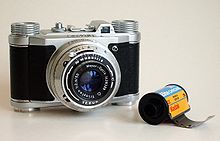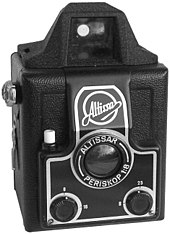Altissa
| Altissa | |
|---|---|
| legal form | GmbH , state-owned company |
| founding | 1904 (as a photographic manufactory engineer Richard Knoll ) |
| resolution | 1959 |
| Reason for dissolution | Incorporation into the VEB Camera and Kinowerke Dresden |
| Seat | Dresden , Germany |
| management |
|
| Number of employees |
|
| Branch | Optics manufacturer |
Altissa is the short version of the company of a differently renamed company of the Dresden camera industry. Altissa is best known as the producer of the Altix cameras.
history
The company was founded in 1904 as "Photographische Manufaktur Ingenieur Richard Knoll" in Dresden . Emil Hofert took it over 22 years later and named it in 1927 as "Factory of photographic articles Emil Hofert vorm. Richard Knoll ”. He started building boxing cameras because the competition from Dresden did not produce this type of camera. Emil Hofert's main idea was that customers could buy simple but precise camera technology with little money. In the following three years Hofert had repeated success with his boxing cameras and presented them regularly at the Leipzig trade fairs . In 1931 there was a reorganization into "Emil Hofert 'Eho' Camera Factory Emil Hofert GmbH", which later was called "'Eho' Camera Factory Emil Hofert GmbH". In 1935 Emil Hofert offered the first stereo box camera. After Emil Hofert's death, his colleague Berthold Altmann took over the company, which then operated as “'Eho' Kamera-Fabrik Emil Hofert GmbH Owner Berthold Altmann”. At that time the company had 60 employees.
It was not until 1941 that the company came up with its still known name Altissa . In the year before, Berthold Altmann decided on the name "Amca-Camera-Werk Berthold Altmann" (Amca = "Altmann-Cameras"). From 1941 to 1952 the company was called "Altissa-Camera-Werk Berthold Altmann". From 1940 the company had to supply the armaments industry. In February 1945 the plant was completely destroyed in the bombing raids on Dresden . In 1946 there was a new beginning with around 30 employees in Blasewitzer Strasse 17. From 1948 onwards, microscopes and camera accessories were manufactured there as "Aldo-Feingeräte GmbH". In 1951 Altissa had 160 employees.
In 1952 Altissa was nationalized . Berthold Altmann left the GDR for the Federal Republic . After conversion into a state-owned company , the company was called "VEB OPTIK Altissa-Camera-Werk". The company was subordinated to the “ Vereinigung Volkseigener Betriebe (VVB) OPTIK” in Jena . Altissa continued to grow and in 1953 employed around 300 people. After further reorganization, Altissa was then called "VEB Altissa-Camera-Werk" and in 1959 it became the "VEB Camera and Kinowerke Dresden", i. H. incorporated into the later VEB Pentacon . While production initially continued in Blasewitzer Strasse, the administration and construction department were incorporated directly into the "VEB Camera and Kinowerke Dresden". Production under the Altissa brand name was soon discontinued; the remaining stocks are sold.

